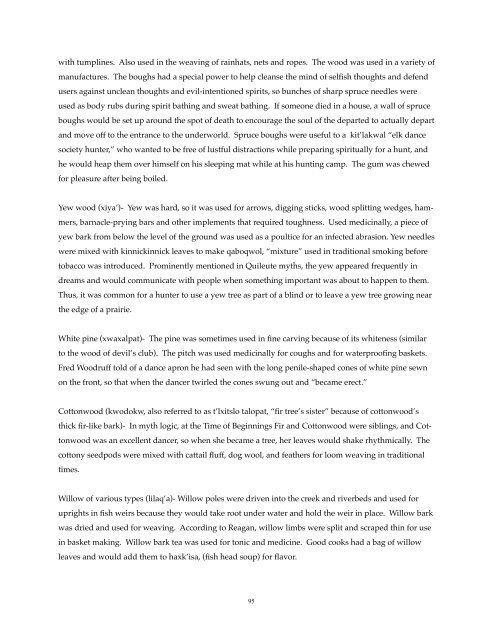The Ozette Prairies of Olympic National Park - Natural Resources ...
The Ozette Prairies of Olympic National Park - Natural Resources ...
The Ozette Prairies of Olympic National Park - Natural Resources ...
Create successful ePaper yourself
Turn your PDF publications into a flip-book with our unique Google optimized e-Paper software.
with tumplines. Also used in the weaving <strong>of</strong> rainhats, nets and ropes. <strong>The</strong> wood was used in a variety <strong>of</strong><br />
manufactures. <strong>The</strong> boughs had a special power to help cleanse the mind <strong>of</strong> selfish thoughts and defend<br />
users against unclean thoughts and evil-intentioned spirits, so bunches <strong>of</strong> sharp spruce needles were<br />
used as body rubs during spirit bathing and sweat bathing. If someone died in a house, a wall <strong>of</strong> spruce<br />
boughs would be set up around the spot <strong>of</strong> death to encourage the soul <strong>of</strong> the departed to actually depart<br />
and move <strong>of</strong>f to the entrance to the underworld. Spruce boughs were useful to a kit’lakwal “elk dance<br />
society hunter,” who wanted to be free <strong>of</strong> lustful distractions while preparing spiritually for a hunt, and<br />
he would heap them over himself on his sleeping mat while at his hunting camp. <strong>The</strong> gum was chewed<br />
for pleasure after being boiled.<br />
Yew wood (xiya’)- Yew was hard, so it was used for arrows, digging sticks, wood splitting wedges, hammers,<br />
barnacle-prying bars and other implements that required toughness. Used medicinally, a piece <strong>of</strong><br />
yew bark from below the level <strong>of</strong> the ground was used as a poultice for an infected abrasion. Yew needles<br />
were mixed with kinnickinnick leaves to make qaboqwol, “mixture” used in traditional smoking before<br />
tobacco was introduced. Prominently mentioned in Quileute myths, the yew appeared frequently in<br />
dreams and would communicate with people when something important was about to happen to them.<br />
Thus, it was common for a hunter to use a yew tree as part <strong>of</strong> a blind or to leave a yew tree growing near<br />
the edge <strong>of</strong> a prairie.<br />
White pine (xwaxalpat)- <strong>The</strong> pine was sometimes used in fine carving because <strong>of</strong> its whiteness (similar<br />
to the wood <strong>of</strong> devil’s club). <strong>The</strong> pitch was used medicinally for coughs and for waterpro<strong>of</strong>ing baskets.<br />
Fred Woodruff told <strong>of</strong> a dance apron he had seen with the long penile-shaped cones <strong>of</strong> white pine sewn<br />
on the front, so that when the dancer twirled the cones swung out and “became erect.”<br />
Cottonwood (kwodokw, also referred to as t’lxitslo talopat, “fir tree’s sister” because <strong>of</strong> cottonwood’s<br />
thick fir-like bark)- In myth logic, at the Time <strong>of</strong> Beginnings Fir and Cottonwood were siblings, and Cottonwood<br />
was an excellent dancer, so when she became a tree, her leaves would shake rhythmically. <strong>The</strong><br />
cottony seedpods were mixed with cattail fluff, dog wool, and feathers for loom weaving in traditional<br />
times.<br />
Willow <strong>of</strong> various types (lilaq’a)- Willow poles were driven into the creek and riverbeds and used for<br />
uprights in fish weirs because they would take root under water and hold the weir in place. Willow bark<br />
was dried and used for weaving. According to Reagan, willow limbs were split and scraped thin for use<br />
in basket making. Willow bark tea was used for tonic and medicine. Good cooks had a bag <strong>of</strong> willow<br />
leaves and would add them to haxk’isa, (fish head soup) for flavor.<br />
95
















